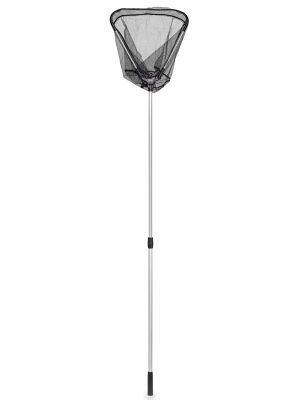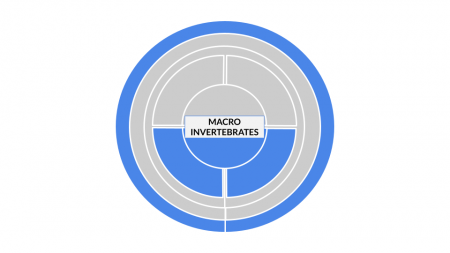Macroinvertebrates
| Method categorization | ||
|---|---|---|
| Quantitative | Qualitative | |
| Inductive | Deductive | |
| Individual | System | Global |
| Past | Present | Future |
In short: Netting, kick sampling and taking benthic cores are methods for collecting macroinvertebrate samples to obtain information about the water quality of a river, lake or pond.
| Netting | Kick sampling | Taking benthic cores | |
| Zone | nekton | riffles in nekton | benthal |
| Speed of water | slow | fast-flowing | still or slow-moving |
| Depth of water | shallow (pond nets), deep (tow nets) | shallow | shallow/ deep (using a boat) |
Netting
What the method does

To standardize pond netting to enable comparisons between different sites or different times at the same site, two points in the water are marked with canes and the net is moved in between the poles for a certain number of times at a constant speed. After netting, the net is emptied into a white tray such as a photographic developing tray. The net should be washed very carefully to remove all the specimens. Some specimens such as nymphs often strongly cling to the net. For tow netting, a net is pulled behind a driving boat to estimate the number of zooplankton in open water. While driving the boat, it is important to keep the opening of the net perpendicular to the water surface to keep the opening of the net at the same size throughout each tow. To measure the distance of towing, it is helpful to add a flowmeter to the net. After towing, the content of the collecting bottle is emptied into a container. To wash off all the zooplankton from the inside of the net, water is splashed from the outside. It can take a considerable amount of time to transfer all the invertebrates from the net into the container. The sample is preserved with 95% ethanol.
Strengths and Challenges
Pond nets can be used for quick surveys of the species that occur in a pond or stream. Within only three minutes of netting, you can find 62% of families and 50% of species that you can catch during 18 minutes of netting (Furse et al. 1981). However, this method is hard to standardize as the net-hauls always need to have the same length and the same speed and these are hard to keep up. This means that this method can be used to get an overview on the number of species, but not to compare species richness and abundances between different sites or points in time. Tow nets can be used in deep, open and weed-free waters. They are suitable for large areas of water, especially for watching zooplankton as this is often distributed in patches. They require more work as at least two people are needed, of which one steers the boat and the other one looks after the net. A major problem is to drive the boat with constant speed to standardize the method. Moreover, turbulence caused by the boat might disturb the position of the net. The nets can become clogged by sediment and phytoplankton, so that they lose their catching efficiency.
The author of this entry is Anna-Lena Rau.
